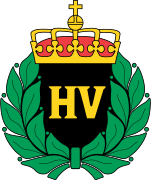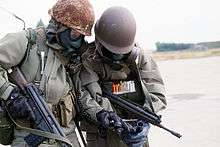Norwegian Home Guard
The Norwegian Home Guard (Norwegian: Heimevernet – "HV"), is a rapid mobilisation force in the Norwegian military. Founded 6 December 1946, it is the second youngest branch in the Norwegian forces after the Norwegian Cyber Force (Norwegian: Cyberforsvaret). It has land, sea and air defense units, and has volunteers and conscript personnel with backgrounds from all branches. Its main focus is local defense and civil support, but it can also detach volunteers for international operations.
| Norwegian Home Guard | |
|---|---|
| Heimevernet | |
 Emblem | |
| Founded | December 6, 1946 |
| Country | Norway |
| Allegiance | Norway |
| Size | 40,000[1] |
| Motto(s) | VERNER VOKTER VIRKER (Protect Guard Work) |
| Commanders | |
| Current commander | Major General Elisabeth Gifstad Michelsen[2] |
Organization
It is divided into districts ("HV-districts"), which again is divided into smaller units, typically covering a single Municipality. In a wartime situation Heimevernet will typically be used to protect the local infrastructure and population.
Strength
The Home Guard has a peacetime personnel number of 500. On high readiness, there are 3,000 Rapid Reaction Force personnel, 16,500 "Strengthening Force" personnel and 20,000 "Follow-up Force" personnel. The total Home Guard Force is approximately 40,000.[3]
Troop exchange
The Home Guard does a troop exchange with the Minnesota National Guard every year.[4] The exchange grew from Norwegian American soldiers sent to Norway to assist resistance fighters in World War II. As part of the exchange, American Guard members are flown to Værnes Air Station and Norwegians are sent to Camp Ripley. Troops complete each other's training, and tour the area.
.jpg)
The Rapid Reaction Forces
From 2005, the Home Guard has recruited for a high readiness force with better trained and equipped personnel. It is called the "Rapid Reaction Force" (Norwegian: Innsatsstyrke). This is the spearhead of the combat force that consists of specially selected, educated and equipped personnel. The force can be mobilized rapidly and is a national resource. Effort strengths contribute to national security.
Soldiers often come from operational armed forces in the Armed Forces and commit themselves to a minimum of 3 years service each and can be ordered on a sharp mission in Norway. They must update and further develop their military competence continuously. They can attend a number of courses, task force missions and other defense activities.
There is one Rapid Reaction Force per district, in total 3,000 men and women. The Rapid Reaction Force is the speartip of the Norwegian Home Guard, and contains flexible and mobile units. It has top priority when concerning weapons, material and training resources. The force is ready to respond within hours to acts of terrorism, bomb threats, and or other emergencies. In peacetime, the RRFs can support the police and civilian community with a variety of tasks, including providing security for the public and enforcing police regulations.
The RRFs are named after operations executed during WW2 by the Norwegian Independent Company 1 (a.k.a. Linge Company):
- Oslofjord HV-district 01: RRF Polar Bear VI
- Oslo and Akershus HV-district 02: RRF Derby
- Telemark and Buskerud HV-district 03: RRF Gunnerside
- Opplandske HV-district 05: RRF Grebe
- Agder and Rogaland HV-district 08: RRF Osprey and Varg
- Bergenhus HV-district 09: RRF Bjørn West
- Møre and Fjordane HV-district 11: RRF Archery
- Trøndelag HV-district 12: RRF Rype
- Sør-Hålogaland HV-district 14: RRF Heron
- Nord-Hålogaland HV-district 16: RRF Claymore
- Finnmark HV-district 17: RRF Ida & Lyra and Delfin
The Naval branch of the Home Guard used to be four RRFs. but the Norwegian government closed the units down in 2017 due to saving costs.
- South: RRF Bundle
- West: RRF Salamander
- North: RRFs Waxwing and Anklet
Platoons
The Rapid Reaction Forces consists of several different platoons within each district. In this way, each district will be able to respond to any kind of incident that could occur, without having to rely on outside help. Each district (with some variations) will have trained operators in these different types of units:
- Jegertropp (Ranger platoon)
- Skarpskyttertropp (Sniper platoon)
- MP-tjeneste (Military Police platoon)
- Hundetjenesten (K9 unit)
- Stabstropp (Staff platoon – (S-1, to S-4), transport & logistics)
- Sambandstropp (Signal platoon)
- Dykkerlag (Diving team – Underwater reconnaissance, explosives-detection)
- Sanitetstropp (Medical platoon)
- Innsatstropper (Infantry platoons)
a Light Mechanized unit has been established in district's 12, 14 and 16. this one is called Multi-Troppen (Multi Platoon). These platoons handle the custom made Geländewagen 290 multi III and is the speartip of the RRF's.[5]
Equipment

Until the end of the 1960s, the Home Guard used second-hand weapons from the Norwegian Army. At the end of the period, the Home Guard was equipped with increasingly modern and heavier weapons.
The Home Guard today uses small arms like the MP-7 submachine guns, HK416[6] automatic rifles, MG-3 machine gun and FN Minimi light machine guns.[7] Additionally, the Barrett M82sniper rifle[8] and Glock 17 pistol[9] are used.
The vehicle fleet consists mainly of Mercedes-Benz G-Class utility vehicles, ambulances and Scania lorries.
Home Guard districts
Region 1
- Oslofjord Heimevernsdistrikt 01 – HV-01 – Rygge
- Oslo og Akershus Heimevernsdistrikt 02 – HV-02 – Lutvann
- Telemark og Buskerud Heimevernsdistrikt 03 – HV-03 – Heistadmoen
- Opplandske Heimevernsdistrikt 05 – HV-05 – Terningmoen
Region 2
- Rogaland Heimevernsdistrikt 08 – HV-08 – Vatneleiren
- Bergenhus Heimevernsdistrikt 09 – HV-09 – Bergenhus
Region 3
- Møre og Romsdal Heimevernsdistrikt 11 – HV-11 – Setnesmoen
- Trøndelag Heimevernsdistrikt 12 – HV-12 – Værnes
- Sør-Hålogaland Heimevernsdistrikt 14 – HV-14 – Drevjamoen
Region 4
- Nord-Hålogaland Heimevernsdistrikt 16 – HV-16 – Elvegårdsmoen
- Finnmark Heimevernsdistrikt 17 – HV-17 – Porsangermoen
See also
References
- https://forsvaret.no/organisasjon/heimevernet
- https://www.facebook.com/MinnesotaNationalGuard/posts/congratulations-to-maj-gen-elisabeth-gifstad-michelsen-who-recently-took-over-as/10157971369952454/
- https://forsvaret.no/hv/org/distr
- "Dayton To Head To Norway For Troop Celebration". CBS Local Media. 15 February 2013. Retrieved 25 January 2014.
- https://www.vg.no/nyheter/innenriks/i/xxWa8/her-er-heimevernets-nye-stridskjoeretoey
- https://forsvaret.no/aktuelt/hv-tilfoeres-flere-nye-vaapen
- https://forsvaret.no/fakta/utstyr/Vaapen/MINIMI--lett-maskingevaer
- https://forsvaret.no/en/facts/equipment/barrett-m82-sniper-rifle
- https://forsvaret.no/en/facts/equipment/p80-pistol
External links
| Wikimedia Commons has media related to Home Guard (Norway). |

